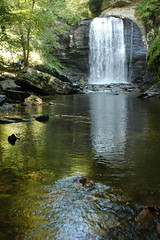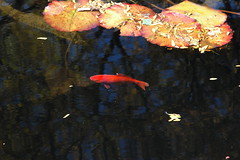- Built Environment
, via Gowanus Lounge - Pruned, via Built Environment
- Strange Maps, via Pruned
Tag Archives: Uncategorized
Francis Morrone on Victorian Flatbush
[Updated 18:45 EST: Added link to Francis Morrone’s personal Web site.]
The third article about Victorian Flatbush in the past two months has caught my eye. They’re all by Francis Morrone, who writes about NYC architecture for the The New York Sun:
- November 24, The Best Balusters on the Block, about Ditmas Park, to the south and east of us.
- October 20, John Petit’s Visionary Home Designs, about Prospect Park South, the historic district just up the block from my home.
- October 13, Generations of Dynamism in Flatbush
The railroad that serves Ditmas Park is the Brighton Line, also known as the Q train, which follows the right of way of the old Brooklyn, Flatbush & Coney Island Railroad, a surface steam railroad eventually purchased and rebuilt by the Brooklyn Rapid Transit Company. The BRT decided to run the Brighton Line in an open cut through Flatbush. This hid the train from view in an area ripe for development as a high-class residential district at the turn of the 20th century.
When the railroad cut was created, they also went from two track to four. Today the outer tracks serve the local stops on the Q line, while the inner tracks serve the express stops of B train, including Church Avenue and Newkirk Avenue. To icnrease the number of tracks, they needed to take land on both sides. This is why the proeprties backing the tracks on the adjacent streets of Marlborough Road (East 15th Street) and East 16th Street are only 75 feet deep instead of the standard 100 feet: they needed an additional 25 feet from each side for the additional right-of-way.
Links:
- Francis Morrone’s personal Web site
New Q Trains
Several years ago, I participated in a focus group field-trip to a mock-up of the new cars design.
I can’t wait.
via Gothamist, via across the park
Addams Family Gardening Values
One of my dreams is to design and grow a border for the Addams family: mandrake, wolfsbane, moonflower, the spikiest and thorniest plants. And everything poisonous I can find.
However, in an urban setting, I have to consider the children, and neighbor’s pets. Seems that some in my neighborhood care to overlook these concerns:
Q. I want to grow the huge, gorgeous red-leafed plants I’ve seen on my neighbors’ stoops in Brooklyn. But I’ve been told they are ricinus, the plant that was used to assassinate the Bulgarian dissident Georgi I. Markov, back in 1978. Please tell me this is not the same ricinus but only a harmless cousin.
A. Ricinus, a k a castor bean, is cousin-free. There is only one species, Ricinus communis. The ricin it contains, primarily in the seed coat, is among the deadliest poisons known. And like many plants in the spurge (Euphorbia) family, it can cause rashes in those who are sensitive to it.
– Poison on the Stoop, New York Times, November 16, 2006
The Times response goes on to note “Yet accidental poisonings are rare.” I haven’t seen seen anyone growing this plant myself, but I would be concerned. It would be easy for the seeds to drop down the steps to the sidewalk. There are dogs I know who eat sticks off the sidewalk. They wouldn’t hesitate to snatch up a shiny seed or ten.
via Brooklyn Record.
Leonids return this weekend
On Sunday, Nov. 19th, Earth will pass through a stream of debris from comet 55P/Tempel-Tuttle. The result: a shower of Leonid meteors.
…
Forecasters differ on when the outburst will occur. Estimates range from 0445 UT to 0630 UT on Nov. 19th (11:45 p.m. on Nov. 18th to 1:30 am EST on Nov. 19th). The timing favors western Europe, Africa, Brazil and eastern parts of North America.
Links:
Last Week, NYC: Botanical Art Exhibition
The Ninth Annual International Juried Botanical Art Exhibition closes this week. The last day is November 17.
The Ninth Annual International Juried Botanical Art Exhibition, on view at The Horticultural Society of New York (HSNY) features a juried selection of works from The American Society of Botanical Artists, Inc. (ASBA). For the past nine consecutive years the show has been co-sponsored by the two cultural non-profits. This unique exhibition will showcase thirty seven pre-eminent artists working in the genre of botanical art worldwide. Included are forty six original works from the U.S., Australia, Canada, Japan, Sweden and the UK rendered in watercolor, graphite, pen and ink, gouache, and colored pencil.
The complexity of plant life is better understood today than in the drawing rooms of the 18th and 19th century, but what intrigues people is that there is so much yet to learn. An artist may be painting a newly discovered plant, a newly hybridized plant, a common garden plant, or one threatened with extinction. Botanical artists today can’t help but be aware that plants are integral to historical lore, contemporary stories, and are harbingers of the future. In this way, plants make fascinating and ever-changing subjects.None of the artists in this exhibition would consider botanical art a dusty, staid repetition of what has come before. Modernism informs and enlivens contemporary botanical art. Compositional ideas originating in abstraction, understanding of negative and positive space, and attempting to convey something more than the scientific facts about the subject are some of the ways the contemporary artist breathes life into the art form.
From the velvety lushness of Iris petals to the abandon of a merry-go-round of marigolds to the brilliant color of beets, the artworks chosen for this exhibition celebrate beauty in plant life abundantly. The lowly cauliflower appears uncommonly exuberant, and the seeds of the acorn squash are exposed to view, meticulously yet robustly rendered. Fritillaria seem to dance across the page. Rarities such as Prairie Smoke, devotionally drawn in pen and ink down to the wispy seed pods demonstrate the range each artist’s unique vision brings to the art form.
This exhibition is evidence of the vitality and range of botanical art in today’s world. As one of the earliest impulses of creativity in humankind, recording the world’s plant life artistically will be part of our existence until the end of time. We are happy to once again contribute to that continuum.
The Horticultural Society of New York
148 West 37th Street, 13th Floor,
New York, NY 10018 (Between Broadway and 7th Avenue)
Gallery hours are from 12:00 – 6:00 pm Monday to Friday and by Appointment.
BlogSpot wigging out … again
Update 07:05 EST: Well, things seem to be working again, I don’t know how long the outage occurred.
You will have been getting “Internal Server Error, Error 500.”
Thanks, BlogSquat.
Recent News
- November 10, 2006: A Spruce from Connecticut
- November 10, 2006: A Science of the Web Begins
- November 10, 2006: Peatlands disappearance of concern
- November 8, 2006: Ground Zero in Middle Age
- November 8, 2006: Nobel laureate has 1 billion tree plan
- October 31, 2006: Capturing Carbon Tips Cost-Benefit Balance in Favor of Conservation
- October 19, 2006: Foreign Invaders From the Past Invade English Countryside, via BldgBlog
- October 2006: Two myths that keep the world poor. Via GrrlScientist.
- October 2006: Finding Exurbia: America’s Fast-Growing Communities at the Metropolitan Fringe, a report from the Brookings Institution. via the Librarian’s Internet Index
Debut on Good Planets are Hard to Find
I’ve just made my debut on today’s issue of Good Planets are Hard to Find. Good Planets was started by Robin and Roger on their blog Dharma Bums. These week it’s hosted by Pam on her blog Tortoise Trail.
Good Planets collects photographs from all over the world submitted by contributors. I submitted one photograph each from four different blog posts over the past month. The photos below are linked to their Flickr photo page, where you can view the image at different resolutions. The captions are linked to the blog posting for the photograph. You can view the Flickr set of all related photos either from the photo page or the blog entry.
 Looking Glass Falls, Pisgah National Forest, North Carolina
Looking Glass Falls, Pisgah National Forest, North Carolina
 Virginia Creeper, North Carolina Arboretum
Virginia Creeper, North Carolina Arboretum
 Llama, NY State Sheep & Wool Festival
Llama, NY State Sheep & Wool Festival
 Goldfish and Lilypad, Brooklyn Botanic Garden
Goldfish and Lilypad, Brooklyn Botanic Garden
Mischrysanthemumry
mischrysanthemumry – hatred of Chrysanthemums.
– A word I just made up
One of my favorite blogs is the Human Flower Project. Every day there’s a new article reporting on some aspect of the importance flowers have in human lives and social structures. Yesterday’s entry is about Chrysanthemums, in particular, but also the general attitudes toward flowers – anything, really – on the basis of its rarity or “commonness.”
There IS such a thing as flower bigotry. Consider pansy disdain and the aspersions cast upon Bradford pear trees, carnations and chrysanthemums. One of our heroes, Pierre Bourdieu, spent many years studying the social and economic structures that underlie such “trivial” opinions. He argued that expressions of taste, even in things as seemingly subjective as flowers, belie an ongoing social struggle. One of the more bonehead—and prevailing—tactics in this culture war is the declared “preference” for things that are rare over things plentiful. The Fall Chrysanthemum Syndrome, if you will.
“The main opposition,” Bourdieu writes in Distinction, “is between the practices designated by their rarity as distinguished,” (what rich and culturally powerful people “like” and do) “and the practices socially identified as vulgar because they are both easy and common.” As chrysanthemums are common come November 1.
…
Chrysanthemum antipathy is nothing terribly new. In a February 1892 edition of Garden and Forest, C.S. Sargent wrote, “It has been said that the popularity of the Chrysanthemum is on the wane. No doubt, the Japanese varieties have been overdone, but that the Chrysanthemum will ever become unpopular I do not believe. There will rather be a return to a larger variety of types, and many of the old kinds will come into favor. Already we see this.” Just as Bourdieu describes, to be “overdone” is anathema. Cultural salvation may come in the form of the “interesting or unusual” or the revival of “old kinds” that, like homespun blankets or Dedham Pottery, have become hard to find. In fact, banishment from shopping centers seems like a strong indication that these flowers are regaining a whiff of unacceptability, the first painful step on the road to grandeur.– Chrysanthemums – Too Human, Human Flower Project [links and my emphasis added]
Some of the ones I loathe are:
- Azaleas (the white-pink-magenta-red blobs-of-color varieties are common as Dandelions here)
- Dandelions (I exterminate them on sight)
- Forsythia (do not a topiary make)
- Violets (soooo very common)
Some of the ones I love are:
- Daffodils
- Daisies (the earliest flower I remember)
- Goldenrod
- Lilacs
- Pansies
- Tulips
Oh, yeah. And mums!
What “common” flowers do you love? Which do you loathe?
